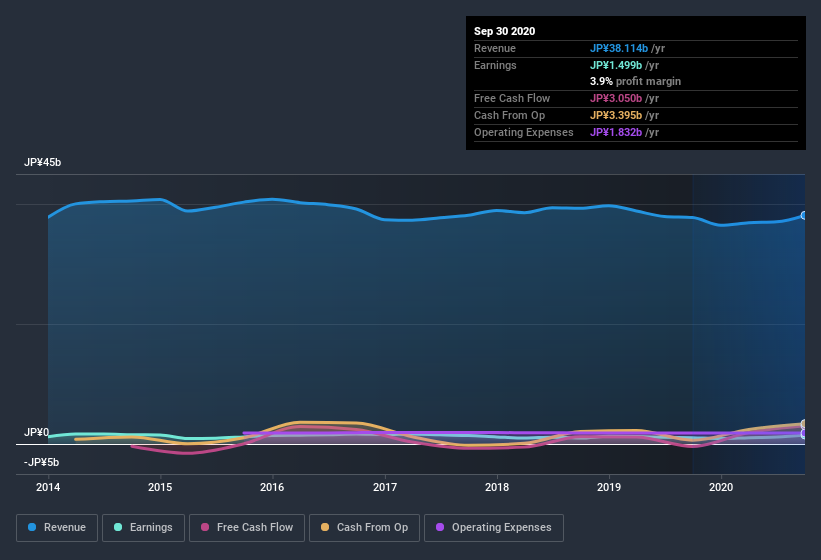
Broadly speaking, profitable businesses are less risky than unprofitable ones. However, sometimes companies receive a one-off boost (or reduction) to their profit, and it's not always clear whether statutory profits are a good guide, going forward. This article will consider whether Watanabe Sato's (TYO:1807) statutory profits are a good guide to its underlying earnings.
We like the fact that Watanabe Sato made a profit of JP¥1.50b on its revenue of JP¥38.1b, in the last year. Interestingly, even though its revenue has been flat over the last few years, its profit has actually increased, as you can see, below.
Check out our latest analysis for Watanabe Sato

Not all profits are equal, and we can learn more about the nature of a company's past profitability by diving deeper into the financial statements. As a result, we think it's well worth considering what Watanabe Sato's cashflow (when compared to its earnings) can tell us about the nature of its statutory profit. Note: we always recommend investors check balance sheet strength. Click here to be taken to our balance sheet analysis of Watanabe Sato.
A Closer Look At Watanabe Sato's Earnings
In high finance, the key ratio used to measure how well a company converts reported profits into free cash flow (FCF) is the accrual ratio (from cashflow). The accrual ratio subtracts the FCF from the profit for a given period, and divides the result by the average operating assets of the company over that time. The ratio shows us how much a company's profit exceeds its FCF.
That means a negative accrual ratio is a good thing, because it shows that the company is bringing in more free cash flow than its profit would suggest. While it's not a problem to have a positive accrual ratio, indicating a certain level of non-cash profits, a high accrual ratio is arguably a bad thing, because it indicates paper profits are not matched by cash flow. Notably, there is some academic evidence that suggests that a high accrual ratio is a bad sign for near-term profits, generally speaking.
Over the twelve months to September 2020, Watanabe Sato recorded an accrual ratio of -0.12. That indicates that its free cash flow was a fair bit more than its statutory profit. Indeed, in the last twelve months it reported free cash flow of JP¥3.1b, well over the JP¥1.50b it reported in profit. Notably, Watanabe Sato had negative free cash flow last year, so the JP¥3.1b it produced this year was a welcome improvement.
Our Take On Watanabe Sato's Profit Performance
As we discussed above, Watanabe Sato has perfectly satisfactory free cash flow relative to profit. Because of this, we think Watanabe Sato's earnings potential is at least as good as it seems, and maybe even better! And on top of that, its earnings per share have grown at 7.2% per year over the last three years. Of course, we've only just scratched the surface when it comes to analysing its earnings; one could also consider margins, forecast growth, and return on investment, among other factors. If you'd like to know more about Watanabe Sato as a business, it's important to be aware of any risks it's facing. Every company has risks, and we've spotted 2 warning signs for Watanabe Sato (of which 1 is concerning!) you should know about.
Today we've zoomed in on a single data point to better understand the nature of Watanabe Sato's profit. But there are plenty of other ways to inform your opinion of a company. For example, many people consider a high return on equity as an indication of favorable business economics, while others like to 'follow the money' and search out stocks that insiders are buying. So you may wish to see this free collection of companies boasting high return on equity, or this list of stocks that insiders are buying.
If you decide to trade Watanabe Sato, use the lowest-cost* platform that is rated #1 Overall by Barron’s, Interactive Brokers. Trade stocks, options, futures, forex, bonds and funds on 135 markets, all from a single integrated account. Promoted
Valuation is complex, but we're here to simplify it.
Discover if Watanabe Sato might be undervalued or overvalued with our detailed analysis, featuring fair value estimates, potential risks, dividends, insider trades, and its financial condition.
Access Free AnalysisThis article by Simply Wall St is general in nature. It does not constitute a recommendation to buy or sell any stock, and does not take account of your objectives, or your financial situation. We aim to bring you long-term focused analysis driven by fundamental data. Note that our analysis may not factor in the latest price-sensitive company announcements or qualitative material. Simply Wall St has no position in any stocks mentioned.
*Interactive Brokers Rated Lowest Cost Broker by StockBrokers.com Annual Online Review 2020
Have feedback on this article? Concerned about the content? Get in touch with us directly. Alternatively, email editorial-team@simplywallst.com.
About TSE:1807
Watanabe Sato
Engages in the contracting and investigation, research, planning, designing, supervision, technical guidance, and consultation of civil engineering construction activities.
Established dividend payer with adequate balance sheet.
Market Insights
Community Narratives




